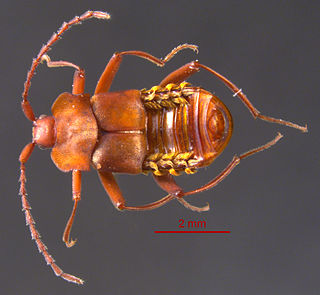
The rove beetles are a family (Staphylinidae) of beetles, primarily distinguished by their short elytra that typically leave more than half of their abdominal segments exposed. With over 66,000 species in thousands of genera, the group is the largest family in the beetle order, and one of the largest families of organisms. It is an ancient group, with fossilized rove beetles known from the Triassic, 200 million years ago, and possibly even earlier if the genus Leehermania proves to be a member of this family. They are an ecologically and morphologically diverse group of beetles, and commonly encountered in terrestrial ecosystems.

Pselaphinae are a subfamily of beetles in the family Staphylinidae, the rove beetles. The group was originally regarded as a separate family named Pselaphidae. Newton and Thayer (1995) placed them in the Omaliine group of the family Staphylinidae based on shared morphological characters.

Ant mimicry or myrmecomorphy is mimicry of ants by other organisms; it has evolved over 70 times. Ants are abundant all over the world, and potential predators that rely on vision to identify their prey, such as birds and wasps, normally avoid them, because they are either unpalatable or aggressive. Some arthropods mimic ants to escape predation, while some predators of ants, especially spiders, mimic them anatomically and behaviourally in aggressive mimicry. Ant mimicry has existed almost as long as ants themselves; the earliest ant mimics in the fossil record appear in the mid-Cretaceous alongside the earliest ants.

Myrmecophily is the term applied to positive interspecies associations between ants and a variety of other organisms, such as plants, other arthropods, and fungi. Myrmecophily refers to mutualistic associations with ants, though in its more general use, the term may also refer to commensal or even parasitic interactions.

Claviger is a genus of beetles in the family Staphylinidae, subfamily Pselaphinae. About 40 species and subspecies are described, divided into two subgenera, Claviger (Claviger) and Claviger (Clavifer). Claviger displays unusual biological adaptations to myrmecophily. This pselaphid is of palearctic distribution.

Pella is a genus of rove beetles.

Dalotia coriaria, the greenhouse rove beetle, is a species of staphylinid rove beetle in the subfamily Aleocharinae. It is used as a predatory biological control agent for the management of pest insects.
Pella recisa is a species of rove beetle in the genus Pella. It was described by Casey in 1911.
Pella carolina is a species of rove beetle in the genus Pella in the subfamily Aleocharinae. It was discovered by Casey in 1911.
This is a glossary of terms used in the descriptions of ants.

Colilodion schulzi is a species of beetles belonging to the family Staphylinidae. This small, robust, reddish-brown rove beetle is known from a single specimen, a 2.37 millimetres (0.093 in) long female. It resembles the species C. concinnus and C. inopinatus with its enlarged antennomeres III, but it is easily distinguished by the greater maximum width and less variable width of these appendages, and by other morphological characteristics. Although its ecology is unknown, the presence of trichomes and the knowledge of related species, such as Staphylinidae suggests that this insect is myrmecophilous. The holotype was collected in 2009 in Palawan (Philippines) while sifting plant debris in a coniferous forest. The species was described in 2016 by the coleopterists Zi-Wei Yin from Shanghai Normal University and Giulio Cuccodoro from the Natural History Museum of Geneva, where the type specimen is part of the collection. The taxon's specific denomination is dedicated to the German myrmecologist Andreas Schulz, collector of the specimen.

Colilodion, sole member of the tribe Colilodionini, is a genus of beetles belonging to the family Staphylinidae and comprising eight species from Southeast Asia.

Symphiles are insects or other organisms which live as welcome guests in the nest of a social insect by which they are fed and guarded. The relationship between the symphile and host may be symbiotic, inquiline or parasitic.
Sceptobius is a genus of rove beetles in the family Staphylinidae. There are at least three described species in Sceptobius.
Sceptobiini is a tribe of rove beetles in the family Staphylinidae. There are at least two genera and about five described species in Sceptobiini.
Goniusa is a genus of rove beetles in the family Staphylinidae. There are at least three described species in Goniusa.

Xenodusa cava is a species of rove beetle in the family Staphylinidae. It is found in North America. It is myrmecophilic, with its larvae living in ant colonies, begging for food and consuming ant larvae.

Oxypodini is a tribe of rove beetles in the family Staphylinidae. There are more than 50 genera and 580 described species in Oxypodini.
Dinardilla is a genus of rove beetles in the family Staphylinidae. There are at least two described species in Dinardilla.
Aenictoteratini is a myrmecophilous tribe of rove beetles in the subfamily Aleocharinae which contains 10 genera, 7 of which are monotypic. In total, there are 17 species currently listed as Aenictoteratini.














